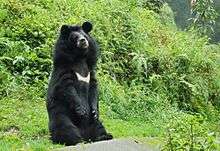Himalayan black bear
The Himalayan black bear (Ursus thibetanus laniger) is a subspecies of the Asian black bear found in the Himalayas of India, Bhutan, Nepal, China and Pakistan.
| Himalayan black bear | |
|---|---|
 | |
| Scientific classification | |
| Kingdom: | Animalia |
| Phylum: | Chordata |
| Class: | Mammalia |
| Order: | Carnivora |
| Family: | Ursidae |
| Genus: | Ursus |
| Species: | |
| Subspecies: | U. t. laniger |
| Trinomial name | |
| Ursus thibetanus laniger Pocock, 1932 | |
| Synonyms | |
| |
Description
It is distinguished from U. t. thibetanus by its longer, thicker fur and smaller, whiter chest mark.[2] During the summer, black bears can be found in warmer areas in Nepal, China, Bhutan, India and Tibet at altitudes of 10,000 to 12,000 feet (3,000 to 3,700 m) up near the timberline. For winter, they descend as low as 5,000 feet (1,500 metres), to more tropical forests. On average, they measure from 56 to 65 inches (140 to 170 cm) nose to tail and weigh from 200 to 265 pounds (91 to 120 kg), though they may weigh as much as 400 pounds (180 kilograms) in the fall, when they are fattening up for hibernation.[3]
Behaviour and ecology
_is_a_rare_subspecies_of_the_Asiatic_black_bear._21.jpg)
Diet
They are omnivorous creatures and will eat just about anything. Their diet consists of acorns, nuts, fruit, honey, roots, and various insects such as termites and beetle larvae. If food is scarce, they may turn to eating livestock such as sheep, goats, and cattle.[3]
Breeding
They reach sexual maturity at approximately three years. Mating occurs in October with usually two cubs born in February, while the mother is still hibernating. The offspring usually stay with their mother into the second year.[3]
Status
This subspecies is listed as 'vulnerable' due to encroachment of human population, forest fires and the timber industries; these have all reduced the bear's habitat. There is also a high mortality rate among the newborn. And even though hunting of the black bear has been forbidden since 1977, there is still a large problem with poaching.[3]
References
- Pocock, R. I. (1932). "The Black and Brown Bears of Europe and Asia: Part II". The Journal of the Bombay Natural History Society. 36 (1): 115–116.
- Pocock, R. I. (1941). The Fauna of British India, including Ceylon and Burma. Mammalia. 2. London: Taylor and Francis.
- Bears Of The World. "Himalayan Black Bear". Bears Of The World. Archived from the original on 20 March 2015. Retrieved 20 March 2015.
External links
- Himalayan black bear versus Bengal tiger at Jigme Dorji National Park, Bhutan